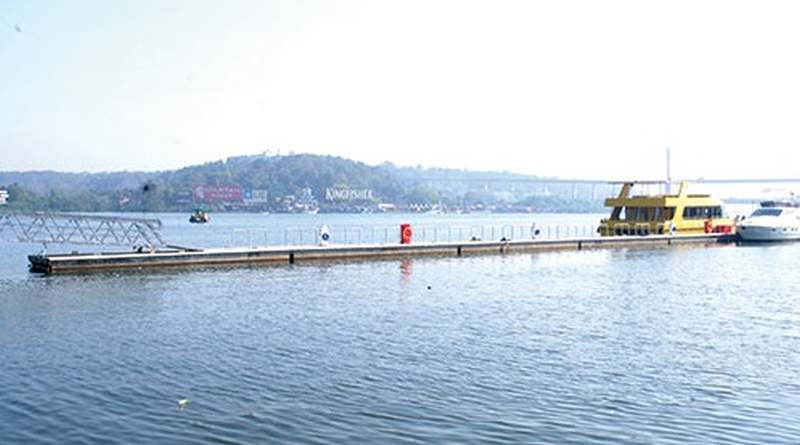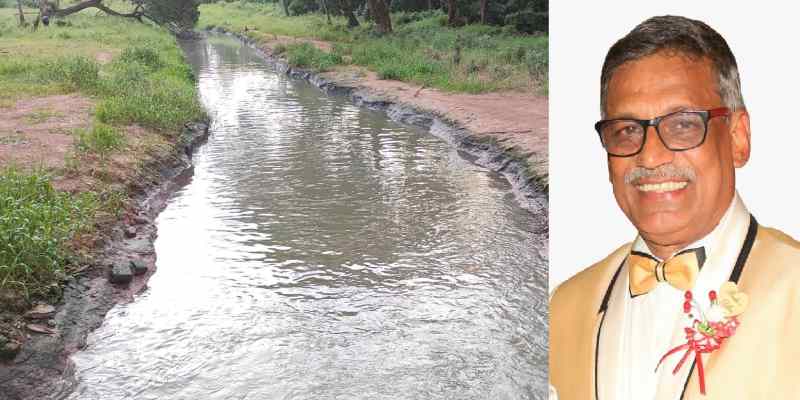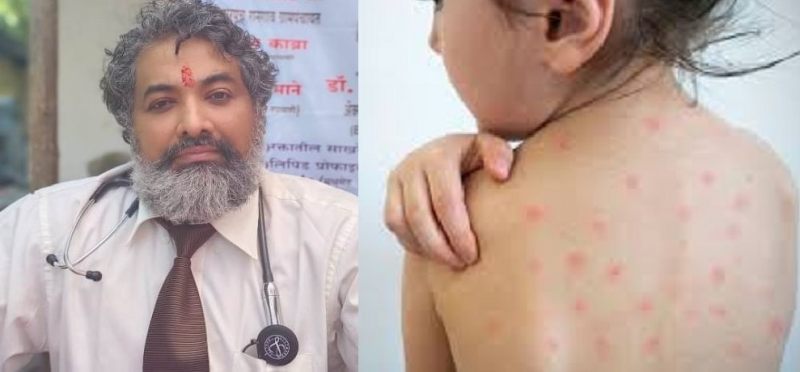Special Report
Goa’s seven ‘national waterways’ can save the State millions each year in fossil fuel costs and carbon credits

PANAJI: A World Bank study claims that one liter of fuel can move 105 tonne-km by inland water transport, against 85 tonne-km by rail and 24 tonne-km by road resulting in huge savings for the transportation sector.
Similarly, the carbon emission per tonne-km is 32-36 gm in the case of container vessels, against 51-91 gm for road transport vehicles, making cargo and container transportation by waterways far more economical and reducing the carbon footprint.
According to logistics and transportation experts, in the next 2-3 years, Goa desperately needs at least 20 new jetties, 10-12 solar or hybrid ferries, while opening up new waterway routes from North to South and East to West to manage traffic congestion on its roads and highways.
By 2030, Goa will need at least 30 new jetties, 25 solar or hybrid boats and a comprehensive waterway network across the length and breadth of the state to meet its transportation needs.
The seven rivers in Goa which have been declared as ‘national waterways’ by the Centre will play an important role in decongesting the road network, says logistics and transportation expert Sudhir Ganguli, a Director and HOD of Research with a premier Indian institute.
The Inland Waterways Authority of India (IWAI), has already started various development works in the State with the objective to facilitate growth of inland water transport.
One of the most urgent is the setting up of environment-friendly floating and fixed jetties which IWAI is working on with the Captain of Ports (CoP). The next is the procurement of alternate-fuel boats and ferries for cargo, container and passenger transportation.
According to Captain James Braganza CoP, Goa, “Once fully developed, inland waterways in the State will have the potential to reduce road traffic and congestion by at least 30-40 per cent, not to forget saving in time and the environmental impact.”
Braganza moots the use of only renewable green energy in inland waterway transport to ensure that the hinterland is not affected by fossil fuel pollution and aquatic and marine life in the waterways do not get affected by the noise caused by the diesel engines of barges, transport and passenger ferries.
“Developing Goan waterways is a five-year project and there are plans to set up a connectivity circuit across the five rivers of the state. Floating jetties are a part of the circuit and are being constructed in phases,” Braganza was quoted as saying by a local Goan newspaper.
According to the CoP, Goa’s first floating jetty at Panaji was commissioned in February this year.
Initial feasibility work is ongoing on three more floating jetties at Old-Goa, Chapora and Campal as part of Phase I of the development of inland waterways.
“Of the three jetties, construction work on the jetty in Old-Goa has already commenced and the project costing Rs 10 crore is funded by the Inland Waterways Authority of India (IWAI),” the CoP informed, elaborating on the development of the national waterways of Goa under several schemes and projects of the Centre, including the Sagarmala project, PM Gati Shakti project and the National Logistics Policy (NLP) scheme.
Special Report
Highly polluted River Sal in South Goa now a gutter or nullah; can no longer be called a river says Ularico Rodrigues

MARGAO: The Goa chapter of the economy and environment Think Tank – Centre for Promoting Indian Economy (CPIE India), in a statement released on Thursday, likened the river Sal – often called the lifeline of Salcete – to a gutter, drain or nullah, which can no longer be called or termed as a river in most places where it flows. According to Prof. Sushant Joshi of the CPIE India, whose team surveyed the river last month, the so-called river is beyond redemption. “We have lost the river and it is just a large gutter or nullah,” Prof. Joshi wrote in the report titled “Pollution of River Sal in South Goa”,
According to social activist and Lion Ularico Rodrigues of Vasco, who has been involved with environmental issues in South Goa, the River Sal is almost dead and polluted throughout its course. “Raw, untreated sewage flows unhindered into the river at various points. Farmers in Seraulim are up in arms as sewage water from the river enters their fields, permanently polluting the soil and damaging their crops,” Ularico said.
Marine and aquatic life in the river has perished and even the percentage of micro plastics, presence of fecal coliform bacteria and other pollutants are nearly four to five times of those as compared to March 2020, during the Covid lock down period, Ularico pointed out. His concerns were echoed by the CPIE India report on Thursday, which collaborated with the concerns mentioned by him.
“The devastation of river Sal is man-made due to improper or mismanagement by various statutory and government bodies like the Goa State Pollution Control Board (GSPCB), the Water Resources Department (WRD), Panchayats of villages along the course of the river and the Government of Goa at large. We have destroyed river Sal and if we do not act aggressively in the next few months, this water body will be lost to Goans forever,” Ularico opined.
On the orders of the High Court, an inspection of the river was carried out by various agencies. At several places, including near the Kudchadkar hospital, raw, untreated sewage was found flowing into the nullah, which eventually connects to the main water body. The nullah in close vicinity of the sewage treatment plant (STP) was also seen filled with sewage water, and plastic and other non-degradable bio-waste floating in it.
Two Sewage Treatment Plants (STPs) at Shirvodem are non functional in spite of several reminders by locals and the gutters next to STPs are full of rotting sewage and plastic and other waste, which are seeping into the water table in the surrounding area.
According to Ularico, the river Sal is polluted to such an extent that wells in the vicinity are also going to be affected. “The quality of water in wells in the localities where the river Sal flows has fallen drastically. About two decades earlier, the water in the wells was potable and could be safely consumed by humans. Today, even animals and cattle are at risk as the level of pollutants and other chemical waste is so high that it could cause serious disease or illness in animals who consume the polluted water,” Ularico claimed.
Special Report
Waterways, logistics and NLP: Goa needs to exploit the full potential of waterways to meet its transportation needs

PANAJI: Without being solely dependent on tourism, if Goa wants to generate employment opportunities for its youth and become a logistics hub in the western zone, it must make a serious move on a war footing to fully exploit its rivers and waterways for goods and cargo transport.
So far, besides passenger transport, the waterways and rivers in Goa were used for iron ore transportation by barges from the mining belt, but with the halt to mining in the State, several barges are lying un-utilized.
Passenger transport via ferries and boats as well as tourism-related boating activity is a mere 7 percent of the overall scope of Goan waterways, claims the Centre for Promoting Indian Economy (CPIE India) in its white paper on “Transportation Issues Plaguing Goa”.
Goa has an advanced, technically competent, local shipbuilding expertise, which has been in existence for centuries, even before the Portuguese landed in the State.
Utilizing the expertise of the local shipbuilding and engineering sector, Goa must go ballistic on using its rivers for goods transport, finding ways and means to use the unused mining barges (with a few modifications) for goods transportation.
This will give a boost to the ancillary manufacturing and services sector that can generate at least a 500 more jobs each year for semi-skilled workers in the State, says CPIE India.
One Goan MLA recently raised eyebrows when he spoke about drone taxis for transportation, but instead of thinking so far, the State must utilize its idle iron ore barges making them operational for logistics and cargo transport.
According to experts, the North-South arterial road network as well as the highways in Goa have reached a saturation point and given the fact that the number of vehicles moving on the roads in Goa is expected to grow by an astounding pace of 120 per cent in the next few years, waterways and river transportation is the only hope for Goa.
Waterway transportation is not just cleaner, greener and cost-effective, it is value for money and can give the logistics sector in Goa a tremendous boost, opines Infrastructure Analyst Ramakant Shinde who heads a Broking Firm in Mumbai.
In terms of logistics and goods transportation, Goa is among the last 4 States in India – according to the 2021 LEADS survey (Logistics Ease Across Different States), which is a crying shame, given the fact that in the Standard of Living index, Goa ranks among the top 3 Indian states.
While other States are concentrating on the planning and implementation of the National Logistics Policy (NLP), Goa lags terribly behind even in basic logistics infrastructure, mostly due to local objections by activists and environmentalists.
When one talks about unemployment in Goa, Goans are to blame. Resistance to change and development is Goa’s Achilles heel that must be tackled with an iron fist on a war footing.
With Goa Chief Minister Dr Pramod Sawant enjoying a comfortable majority, the government must not hesitate to move forward in developing Goa into a logistics hub, implementing the NLP and fully utilizing the natural resources in terms of waterways and rivers for cargo and logistics.
Special Report
Superstitions abound, even as Malwani, Ganesh Nagar, Kandivali West and other Mumbai slum pockets sit on a Measles bomb: Dr Pranav Kabra

MUMBAI: Many households in the slum pockets of Mumbai at Malwani, Ganesh Nagar and Kandivali West resort to traditional medicines, folklore, black magic and everything else to treat measles, instead of vaccination, professional doctor’s advice and allopathic medicines.
Others prefer hanging neem leaves at the doors of their slums and believe it will protect his children. Still others believe that Shitala Mata, a form of Durga Mataa – a goddess who carries holy water and a broom can cure the otherwise very contagious disease. Some even consider the disease as a blessing from the goddess.
According to some old belief rampant both in cities and villages, measles is caused by the anger of Sitala Mata. Superstitious people claim that when a child is infected with measles, it is actually the goddess herself within the victims.
Some elders suggest that the infection should not be treated by any medication or vaccine as it is believed that the goddess will leave the body in 6-10 days on her own.
It is also said that Sitala Mata is among the seven sisters who live in the neem tree. They are known for bringing epidemic diseases. And this is why shrines to Sitala Mata are found near neem trees.
Neem is also known for eradicating chicken pox and measles according to traditional belief and folklore.
According to a survey conducted by the Raksha Hospital Research Forum (RHRF), a unit of the Raksha Multispecialty Hospital (RMH) in suburban Malad, slum pockets in heavily congested slum localities like Malwani, Ganesh Nagar and Kandivali West in the western suburbs are sitting on a measles bomb, with 3-4 kids per shanty in most cases and superstitious beliefs predominant among the dwellers.
Slum dwellers in these hotbeds for the very contagious Measles virus which is fast spreading in Mumbai believe in superstition and folklore and avoid medicines and vaccination preferring to abide by traditional beliefs.
With the Brihanmumbai Municipal Corporation (BMC)confirming an outbreak of Measles in various slum pockets of Mumbai and neighbouring areas, experts at the Raksha Hospital Research Forum presently expect more than 100 to 130 cases of the Measles in the Mumbai Metropolitan Region in the next few days.
Dr Pranav Kabra MD and Managing Director of the RMH who heads the RHRF said that their estimates suggest more than 100 to 130 cases.
“As schools have reopened and kids have started going to school there is great possibility of the disease spreading,” Dr Kabra suggests.
The BMC must concentrate on pockets like Malwani, Govandi, Dharavi, Ganesh Nagar (Kandivali) and other slum pockets where the population density is very high and several children could be living in a single shanty, Dr Kabra said, adding that even street kids could be possibly infected with the Measles virus.
“In the recent outbreak, since about 50 per cent of the infected kids also include those who have been vaccinated earlier, vaccination alone is not enough to prevent infection and parents should be extra careful about the situation,” Dr Kabra opined.









































